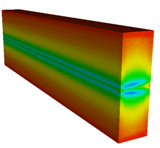Speaker
Alexander RYAZANOV
(KURCHATOV INSTITUTE)
Description
The effect of the 7 TeV proton beam irradiation on degradation of physical mechanical properties of graphite
collimator materials for LHC is very important for the understanding of stability the collimators during operation
of the LHC. At such high energies the carbon atoms in graphite collimator materials of LHC can get also
very high energy with primary knock on carbon atoms (PKA) reaching an energy of up to hundred GeV due to
elastic collisions with secondary particles formed in nuclear reactions. Carbon PKA atoms with such high energy
will produce radiation damage. The radiation resistance of graphite collimator materials will be determined by
the microstructure change under irradiation and defect cluster formation in atomic collision cascades. The main
aim of these investigations is to measure the effect of fast particle irradiation (carbon ions) on physical-mechanical
property changes of different graphite materials: thermal conductivity, thermal expansion coefficient, mechanical
properties (including the measurements of compression ultimate tensile stress, dynamic elastic module, static elastic module),
electrical resistivity, lattice constant and microstructure change.
Samples of various types of graphite collimator materials prepared by different firms for CERN were investigated:
C-C composite graphite REC, C-C composite graphite material AC and high-density graphite material R4SSO.
The obtained results for the measurements of initial physical-mechanical properties of these materials and
effect of irradiation of carbon ions with an energy of 5 MeV on radiation swelling and radiation erosion of these
materials are discussed here. The microstructure investigations of irradiated samples have been performed as
a function of the irradiation dose of fast carbon ions up to total dose of carbon ions 1018 cm-2. The performed
investigations shown that best radiation resistance properties including dose dependence of radiation swelling
at room temperature has composite material R4SS0. Other C-C composite materials such as REC and AC
have not so high radiation resistance properties that were confirmed by the dose dependence of radiation swelling.
Co-authors: BRUCHANOV A.n. (Kurchatov Institute), CHUGUNOV O.k. (Kurchatov Institute), LATUSHKIN S.t. (Kurchatov Institute), PRICHODKO K.e. (Kurchatov Institute), UNEZEV V.n. (Kurchatov Institute), ASSMANN Ralph (CERN), ABERLE Oliver (CERN), BERTARELLI Alessandro (CERN)
Primary author
Alexander RYAZANOV
(KURCHATOV INSTITUTE)
Co-authors
Alessandro BERTARELLI
(CERN)
K.E. PRICHODKO
(KURCHATOV INSTITUTE)
O.K. CHUGUNOV
(KURCHATOV INSTITUTE)
Oliver ABERLE
(CERN)
Ralph ASSMANN
(CERN)
S.T. LATUSHKIN
(KURCHATOV INSTITUTE)
V.N. UNEZEV
(KURCHATOV INSTITUTE)




